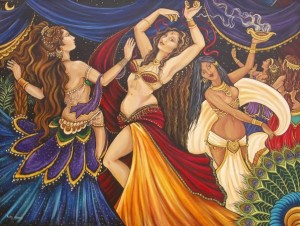 Bellydance is a western term for “Dance of the East” or “Oriental dance”.
Bellydance is a western term for “Dance of the East” or “Oriental dance”.
The art of belly dancing originated from the Middle East and other Arabic influenced regions centuries ago. For women, it was practiced as a celebration of life, embracing femininity, fertility and womanhood. Male bellydancers were the first entertainers. Turkish and Lebanese men trained and dance it as a form of classical art and culture. Men were the first performers as it was not, in the past socially accepted for women to dance in public. Since late 1890’s, it became popular in western countries.
We have since come a long way. With modernity, society recognizes belly dancing as a celebration of life and we are lucky to be liberated to practice this art form in both private and public settings.
Benefits of bellydancing are both mental and physical.
The origins of Belly Dance are buried deep in the social history of the Middle East, but today, dancers use the same core dance moves and techniques that would have been used by their ancient predecessors. Those core movements form the heart of the dance we practice today.
“The heart of the artistic spirit is personal creativity, and the essence of creativity is to create new ideas, new artistic works, new ways of presenting classic material, and evolution of new forms. Dance, of course, is an art form, so dance too evolves “
– Belly Dancer Shira
And from that ethnic and folk heart, the modern dance has evolved – diversified – into the varied styles we now call “Belly Dance”
“Belly dance is an individually creative expression of the core moves and core concepts and each belly dancer interprets the music in her own unique way. In one sense it could be said that there are as many belly dance styles as there are belly dancers..”
– Belly Dancer Atéa
Egyptian Dance/Raks Sharki/Oriental Dance – The Egyptian style belly dancer aims to communicate a visual interpretation of the rhythm and emotions of the music.
Oriental Style, by its very nature, is a solo dance. People frequently refer to “raqs sharqi” as the “women’s solo dance”,
Turkish Dance/Oryantal Dansi – Turkish belly dance uses the belly dance moves and core belly dance techniques of classic belly dance in a generally more outwardly expressive, and energetic manner than other versions of Eastern belly dance.
Turkish belly dancing has been strongly influenced by the Romani (Gypsy) people
Cabaret Dance – Belly dancers have used the word cabaret since the 1960’s to describe the glittery sequined look and dance style that is intended for performing in a “show-business” venue.
The look is often very glamorous, with sequins, beads, and glittery fabrics.
Tribal Belly Dance – Tribal style belly dance is often performed by a troupe of dancers. Tribal dancers combine dance movements, musical selections, and costuming from a variety of cultures and historical eras, adding their own modern-day innovations. It has been described as having an “earthy” interpretation of the core moves and music.
Gypsy Belly Dance – The dance is known for its passion, exuberance, and high energy. There is often the use of props such as tambourines and finger cymbals.
Folkloric Dance – The dance, music, and costumes are more closely allied to the ethnic basis from which belly dance has evolved. Also known as Baladi (of the people/country), the movements are earthy and grounded; the music is traditional.
Fusion Belly Dance – We like to say that the Fusion style combines the best of the ancient and modern bellydance steps and moves, and brings them together in a fun, creative, and accessible way.
